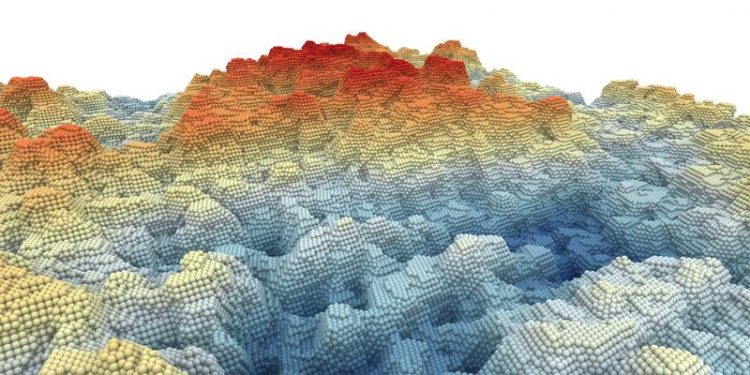Freiburg researcher investigate the origins of surface texture

Surfaces of different materials always develop surface roughness with identical statistical properties. Photo: AG Pastewka
Prof. Dr. Lars Pastewka from the Simulation group at the Department of Microsystems Engineering at the University of Freiburg and his team have simulated such mechanical loads in computer simulations.
The researchers found out that surfaces made of different materials, which show distinct mechanisms of plastic deformation, always develop surface roughness with identical statistical properties. They published their results in the freely accessible online journal Science Advances.
Geological surfaces, such as mountain ranges, are created by mechanical deformation, which then leads to processes such as fracture or wear. Synthetic surfaces typically go through many steps of shaping and finishing, such as polishing, lapping, and grinding, explains Pastewka.
Most of these surface changes, whether natural or synthetic, lead to plastic deformations on the smallest atomic length scale: “Even at the crack tips of most brittle materials such as glass, there is a finite process zone in which the material is plastically deformed,” says the Freiburg researcher. “Roughness on these smallest scales is important because it controls the area of intimate atomic contact when two surfaces are pressed together and thus adhesion, conductivity and other functional properties of surfaces in contact.”
In collaboration with colleagues from the Karlsruhe Institute of Technology, the École Polytechnique Fédérale de Lausanne/Switzerland, and the Sandia National Laboratories/USA, and funded by the European Research Council (ERC), Pastewka and his group were able to simulate the surface topography for three reference material systems at the JUQUEEN and JUWELS supercomputers at the Jülich Supercomputing Centre, which included monocrystalline gold, a high entropy alloy of nickel, iron and titanium, and the metallic glass copper-zirconium, in which the atoms do not form ordered structures but an irregular pattern.
Each of these three materials is known to have different micromechanical or molecular properties. The scientists now investigated the mechanism of the deformation and the resulting changes in the atomic scale both within the solid and on its surface.
Pastewka, who is also a member of the Cluster of Excellence Living, Adaptive and Energy-autonomous Material Systems (livMatS), and his team found that despite their different structures and material properties, all three systems, when compressed, develop rough surfaces with a so-called self-affined topography.
This means that the systems have identical geometric structures regardless of the scale on which they are observed: Surface topography in a virtual microscope at the nanometer scale cannot be distinguished from the structure of mountain landscapes at the kilometer scale. “This is one explanation,” says Pastewka, “as to why an almost universal structure of surface roughness is observed in experiments.”
Original publication:
Hinkle, A. R., Nöhring, W. G., Leute, R., Junge, T., Pastewka, L. (2019): The emergence of small-scale self-affine surface roughness from deformation. In: Science Advances, Vol. 6, no. 7. DOI: 10.1126/sciadv.aax0847
Contact:
Prof. Dr. Lars Pastewka
Department of Microsystems Engineering
Albert-Ludwigs-Universität Freiburg
Tel.: 0761/203-67480
E-Mail: lars.pastewka@imtek.uni-freiburg.de
https://www.pr.uni-freiburg.de/pm-en/press-releases-2020/the-origins-of-roughnes…
Media Contact
All latest news from the category: Materials Sciences
Materials management deals with the research, development, manufacturing and processing of raw and industrial materials. Key aspects here are biological and medical issues, which play an increasingly important role in this field.
innovations-report offers in-depth articles related to the development and application of materials and the structure and properties of new materials.
Newest articles

A ‘language’ for ML models to predict nanopore properties
A large number of 2D materials like graphene can have nanopores – small holes formed by missing atoms through which foreign substances can pass. The properties of these nanopores dictate many…

Clinically validated, wearable ultrasound patch
… for continuous blood pressure monitoring. A team of researchers at the University of California San Diego has developed a new and improved wearable ultrasound patch for continuous and noninvasive…

A new puzzle piece for string theory research
Dr. Ksenia Fedosova from the Cluster of Excellence Mathematics Münster, along with an international research team, has proven a conjecture in string theory that physicists had proposed regarding certain equations….



